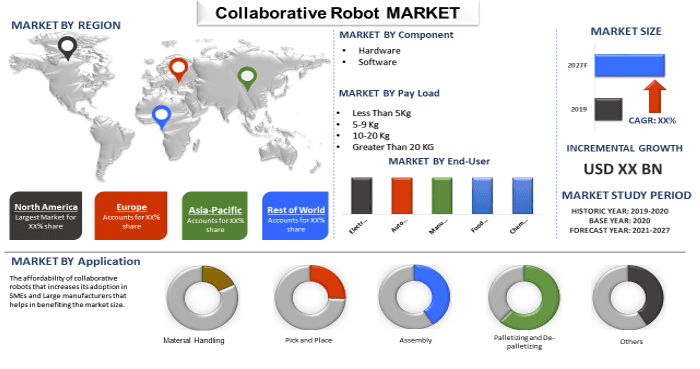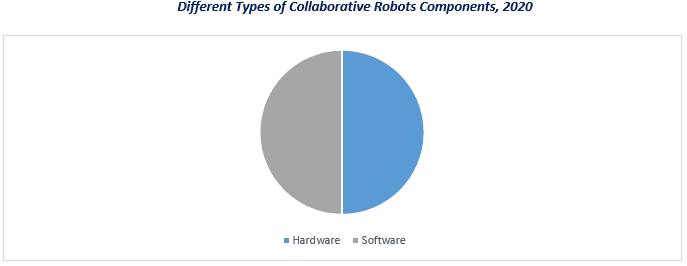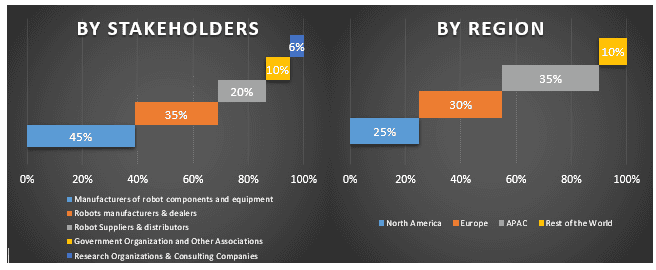- Home
- About Us
- Industry
- Services
- Reading
- Contact Us
Collaborative Robot Market: Current Analysis and Forecast (2021-2027)
Emphasis on Component (Hardware, Software); Pay Load (Less than 5kg, 5-9kg, 10-20kg, greater than 20kg); Application (Material Handling, Pick and Place, Assembly, Palletizing and De Palletizing, Others), End-User (Electronics, Automotive, Manufacturing, Food and Beverage, Chemicals and Pharmaceuticals) and Region/Country

The global collaborative robot market was stood around US$1 billion in 2020 and is expected to showcase the double-digit growth during the forecast period (2021-2027). Increasing focus on ongoing and upcoming trends such as digitization, IoT and Industry 4.0 coupled with the rising number of automotive manufacturing plants and rapid urbanization in the region is driving the growth of the collaborative robot market. For instance: As per Statista, the degree of urban population in 2020 is increasing and expected to have an influential growth rate in the forecasted period as well. Hence, encourage the adoption of collaborative robots for different industries in urbanization region around the world. Moreover, the high Return on Investment (ROI) derived from the deployment of collaborative robots and its benefits for businesses of all sizes in terms of general competitiveness, increased production, and enhanced product quality which in turn would proliferate the market demand for cobots in projected years.
The outbreak of coronavirus pandemic in 2020 has adversely impacted the market share of collaborative robots. The restriction imposed across the globe on travel and shutdown of all the industrial and commercial activities, manufacturing industries, others have disrupted the demand for collaborative robots. However, robotics and automation are playing a very crucial role as the world is continuously fighting the rapid spread of the COVID-19 pandemic in healthcare industry. In addition, industries such as automobile, and manufacturing industries where IoT, robotics solution played an important role has seen slump for a short period in 2020. For instance: China captures 27% of India’s automotive parts import and disruption in the supply-demand ecosystem has halted production process and blocked the investments and cash delays.

Universal Robots, FANUC, ABB, Techman Robot, KUKA, Doosan Robotics, Denso, YASKAWA, Precise Automation, Rethink Robotics, MABI Robotic, FrankaEmika, Comau , F&P Robotics , Stäubli etc, are some of the prominent players operating in the Global Collaborative Robot Market. Several M&As along with partnerships have been undertaken by these players to facilitate customers with hi-tech and innovative products/technologies.
Insights Presented in the Report
“Amongst Component, Hardware Collaborative Robot segment holds the major share”
Based on Component, the market is classified into hardware and software. The hardware segment generated held the significant share in the market in 2020 because it requires a significant amount of fixed and interlocked engineering controls such as robotics arms.
“Amongst End-Use, automotive Segment holds the major share”
Based on End-Use, the market is segmented into electronics, automotive, manufacturing, food and beverages and chemical and pharmaceuticals. In 2020, the automotive segment dominated the collaborative robot’s market. This segment would witness a considerable CAGR during the forecast period (2021-2027F) owing the usage of collaborative robots for a variety of applications such as handling, welding, assembling, and disassembling, dispensing extensively.
“Amongst application, material handling segment holds the major share”
Based on application type, the market is classified into material handling, pick and place, assembly, palletizing and de-palletizing and others. The material handling segment generated prominent revenue share in 2020. Handling tasks such as pick and place or palletizing are among the mundane and repetitive in nature for the human workers. Machine tending requires workers to stand for long hours. Hence, collaborative robots are able to automate a machine tending process during off hours without any supervision, boosting productivity.
“North America represents one of the largest markets of Global Collaborative Robot Market”
For a better understanding of the market dynamics of the Global Collaborative Robot Market, a detailed analysis was conducted for different regions including Asia Pacific, North America, Europe and Rest of the World. North America dominated the market in 2020. It is majorly attributed to the rise in the robotic surgery in U.S.
Reasons to buy this report:
- The study includes market sizing and forecasting analysis validated by authenticated key industry experts
- The report presents a quick review of overall industry performance at one glance
- The report covers an in-depth analysis of prominent industry peers with a primary focus on key business financials, product portfolio, expansion strategies, and recent developments
- Detailed examination of drivers, restraints, key trends, and opportunities prevailing in the industry
- The study comprehensively covers the market across different segments
- Deep dive regional level analysis of the industry
Customization Options:
Global Collaborative Robot Market can further be customized as per the requirement or any other market segment. Besides this, UMI understands that you may have your own business needs, hence feel free to connect with us to get a report that completely suits your requirements.
Table of Content
Analyzing the historical market, estimation of the current market, and forecasting the future market of the global Collaborative Robot market were the three major steps undertaken to create and analyze the adoption of collaborative robot system in major regions globally. Exhaustive secondary research was conducted to collect the historical market numbers and estimate the current market size. Secondly, to validate these insights, numerous findings and assumptions were taken into consideration. Moreover, exhaustive primary interviews were also conducted, with industry experts across the value chain of the global collaborative Robot Market. Post assumption and validation of market numbers through primary interviews, we employed a top-down/bottom-up approach to forecasting the complete market size. Thereafter, market breakdown and data triangulation methods were adopted to estimate and analyze the market size of segments and sub-segments the industry pertains to. Detailed methodology is explained below:
Analysis of Historical Market Size
Step 1: In-Depth Study of Secondary Sources:
Detail secondary study was conducted to obtain the historical market size of the Global Collaborative Robot Market through company internal sources such as annual report & financial statements, performance presentations, press releases, etc., and external sources including journals, news & articles, government publications, competitor publications, sector reports, third-party database, and other credible publications.
Step 2: Market Segmentation:
After obtaining the historical market size of the Global Collaborative Robot Market, we conducted a detailed secondary analysis to gather historical market insights and share for different segments & sub-segments for major regions. Major segments included in the report as type of Collaborative Robot, component, pay load, end-user and application. Further country-level analyses were conducted to evaluate the overall adoption of diagnostic testing models in that region.
Step 3: Factor Analysis:
After acquiring the historical market size of different segments and sub-segments, we conducted a detailed factor analysis to estimate the current market size of global Collaborative Robot market. Further, we conducted factor analysis using dependent and independent variables such as increasing type of Collaborative Robots and increasing adoption of different type of Collaborative Robot material. A thorough analysis was conducted for demand and supply-side scenarios considering top partnerships, merger and acquisition, business expansion, and product launches in the global Collaborative Robot market sector across the globe.
Current Market Size Estimate & Forecast
Current Market Sizing: Based on actionable insights from the above 3 steps, we arrived at the current market size, key players in the Global Collaborative Robot Market, and market shares of the segments. All the required percentage shares split, and market breakdowns were determined using the above-mentioned secondary approach and were verified through primary interviews.
Estimation & Forecasting: For market estimation and forecast, weights were assigned to different factors including drivers & trends, restraints, and opportunities available for the stakeholders. After analyzing these factors, relevant forecasting techniques i.e., top-down/bottom-up approach was applied to arrive at the market forecast about 2027 for different segments and subsegments across the major markets globally. The research methodology adopted to estimate the market size encompasses:
- The industry’s market size, in terms of value (US$) and the adoption rate of global collaborative robot market across the major markets domestically
- All percentage shares, splits, and breakdowns of market segments and sub-segments
- Key players in the global collaborative robot market in terms of products offered. Also, the growth strategies adopted by these players to compete in the fast-growing market
Market Size and Share Validation
Primary Research: In-depth interviews were conducted with the Key Opinion Leaders (KOLs) including Top Level Executives (CXO/VPs, Sales Head, Marketing Head, Operational Head, and Regional Head, Country Head, etc.) across major regions. Primary research findings were then summarized, and statistical analysis was performed to prove the stated hypothesis. Inputs from primary research were consolidated with secondary findings, hence turning information into actionable insights.

Split of Primary Participants in Different Regions
Market Engineering
Data triangulation technique was employed to complete the overall market estimation and to arrive at precise statistical numbers of each segment and sub-segment of the global collaborative robot market. Data was split into several segments & sub-segments post studying various parameters and trends in the areas of type and their type of the global Collaborative Robot market.
The main objective of the Global Collaborative Robot Market Study
The current & future market trends of Global Collaborative Robot Market were pinpointed in the study. Investors can gain strategic insights to base their discretion for investments from the qualitative and quantitative analysis performed in the study. Current and future market trends were determined the overall attractiveness of the market at a regional level, providing a platform for the industrial participant to exploit the untapped market to benefit as a first-mover advantage. Other quantitative goals of the studies include:
- Analyze the current and forecast market size of Global Collaborative Robot Market in terms of value (US$). Also, analyze the current and forecast market size of different segments and sub-segments
- Segments in the study include component, application, end-use, pay-load
- Define and analysis of the regulatory framework for the Global Collaborative Robot Market industry
- Analyze the value chain involved with the presence of various intermediaries, along with analyzing customer and competitor behaviors of the industry
- Analyze the current and forecast market size of the Global Collaborative Robot Market for the major region
- Major regions studied in the report include Asia Pacific, Europe, North America and Rest of the world.
- Company profiles of the Global Collaborative Robot Market and the growth strategies adopted by the market players to sustain in the fast-growing market
Deep dive regional level analysis of the industry
Related Reports
Customers who bought this item also bought










